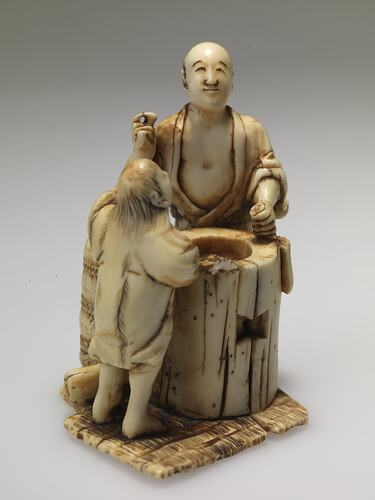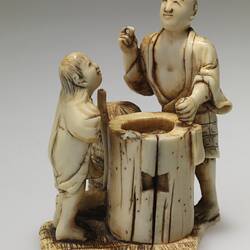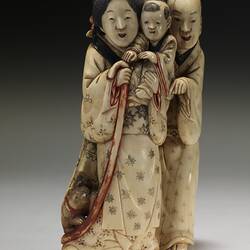Summary
Carved ivory figurative group (okimono) of a street vendor and child, manufactued in Japan during the early Meiji Period (1868-1880)
An okimono is an object specifically created for display, and typically depicts domestic scenes of farms, fishermen, and children and occasionally, studies of birds, animals and flowers. Similar to, but larger than netsuke, Okimono were traditionally displayed in the tokonoma, or alcove. During the Meiji period (1868-1912), many okimono were made for export to the west.
This okimoni represents a Tsuki-ya, a vendor who would travel around the city and, in the barrel rice mill depicted, would polish the husks off rice grains for a charge to turn brown rice into white rice.
Physical Description
Small ivory carving of a man standing at a tub with a mesh cover, with a bushel at his side. A child stands to his right. There is a missing piece to the left of the man (perhaps another figure). No markings.
More Information
-
Collection Names
-
Collecting Areas
-
Acquisition Information
Cultural Gifts Donation from Dr Will Twycross, 23 Jan 2009
-
Acknowledgement
Donated through the Australian Government's Cultural Gifts Program
-
Place & Date Made
-
Place & Date Exhibited
Royal Exhibition Building (REB), Nicholson Street, Carlton, Greater Melbourne, Victoria, Australia, 1880-1881
-
Collector
Mr John Twycross, Elsternwick, Greater Melbourne, Victoria, Australia, 1881
-
Classification
Royal exhibition building, International exhibitions, Exhibition heritage
-
Category
-
Discipline
-
Type of item
-
overall dimensions
40 mm (Width), 38 mm (Depth), 53 mm (Height)
-
Maximum dimensions
40 mm (Length), 37 mm (Width), 49 mm (Height)
Measurement From Conservation.
-
Keywords
Decorative Arts, Exhibitions: Melbourne International, 1880-1881, Ivory, Japanese Art, Royal Exhibition Building



